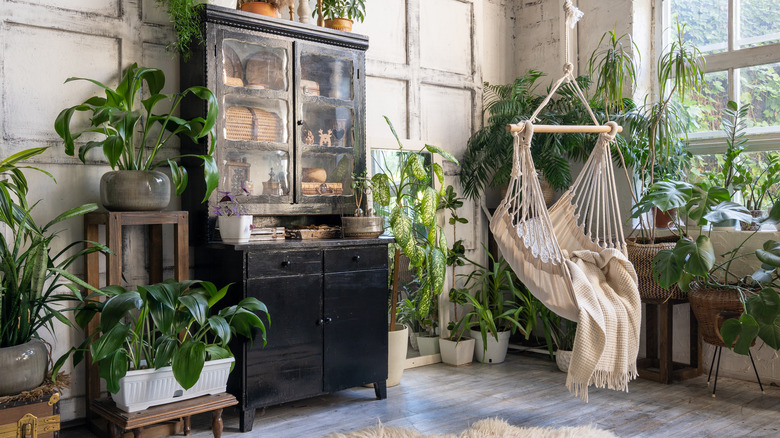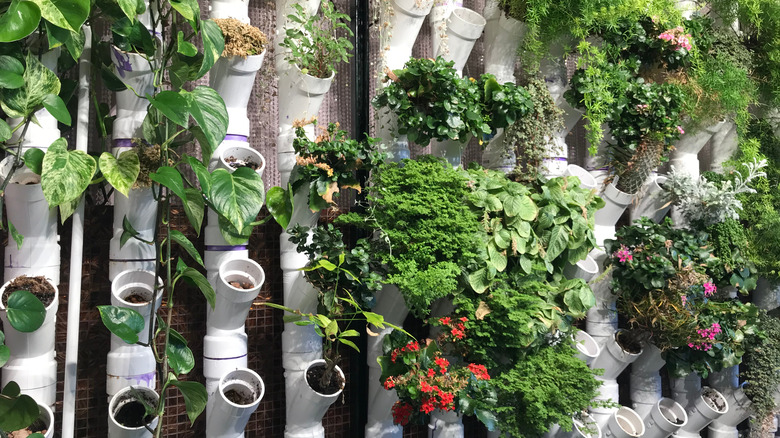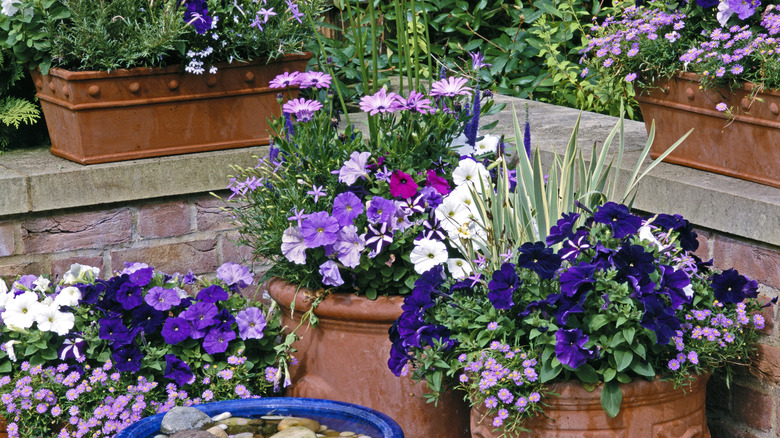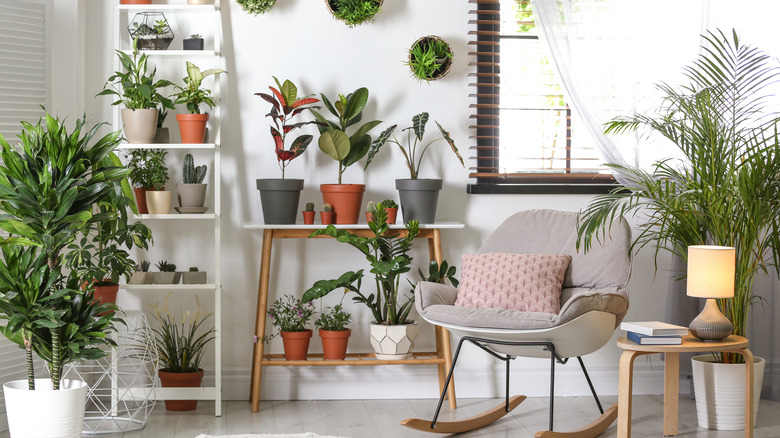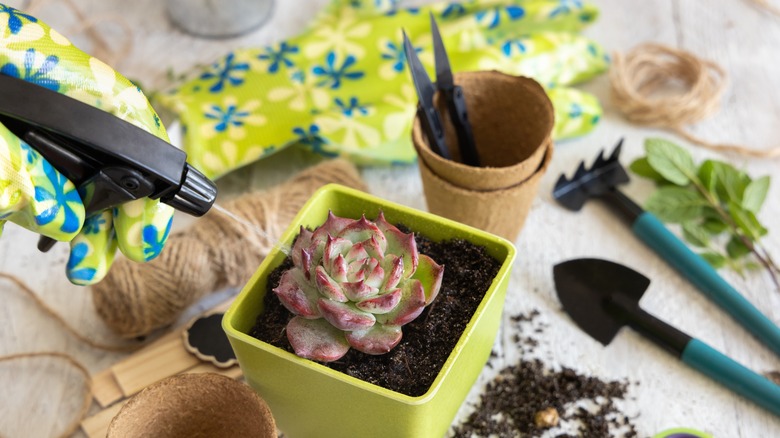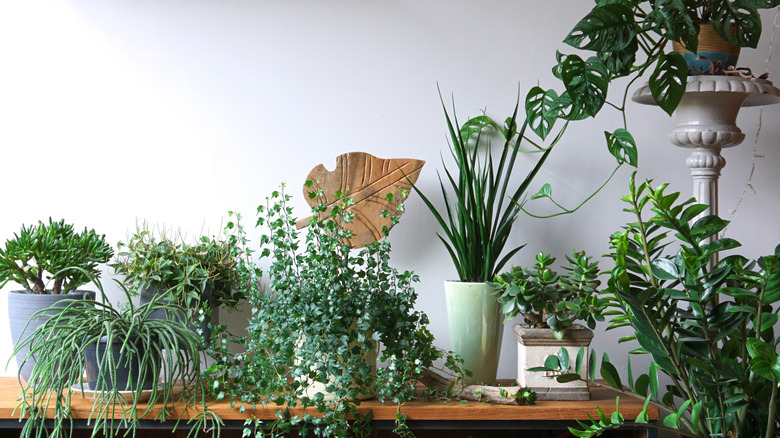5 Tips For Creating The Perfect Indoor Garden
We may receive a commission on purchases made from links.
"Make smart choices" is perhaps the most famous advice ever given to a novice by a person of experience. Those words of caution hold even more true in the gardening world, where the earliest decisions you make can either loft you into a perpetual state of bliss or overwhelm you when the success you thought would come so easily evaporates into thin air.
There are many different ways you can go right or wrong in choosing what, how, and where to plant an indoor garden. According to the experts at Parkseed, the first task is all about location. That spot could be an entire room (as above), an enclosed patio or porch, or even a windowsill — the key ingredient is daylight. Don't have any? Then you'll need to invest in artificial lights, which also means you can grow your plants anywhere you have room.
Another important variable is temperature because your plants need some warmth to grow, but you don't want to bake them in heat. Now consider what kind of plants you want to raise. Would you like a variety of flowers that each bloom at a different part of the year so you always have a fresh bouquet around? Would you like larger "statement" plants that act as accents to your furniture? How about growing things to eat?
These are big decisions that need to be made, but once you've created a roadmap for yourself, indoor gardening becomes simpler.
1. Gardening kits
When you're picking which plants you want to raise, you'll want to picture them fully grown. Some remain petite throughout their lifespans, but others are like Dalmatians; they start cute and adorable, but eventually, they're knocking things over.
For a neophyte, the surest way to navigate any potential nightmare scenario is known as "smart gardens" or garden kits. These are something like driverless cars in that most of what you do is wait for your garden to appear, and the real work is done by LED lights on a timer and hydroponics. It helps that many companies offer an assortment of plants (especially herbs like basil, mint, and thyme) with a predictable growth rate and size in adulthood. There's even a digital readout that will tell you when it's time to feed your plants. Click and Grow has choices along those lines, and Aero Garden Harvest Elite on Amazon has a huge variety and more than 10,000 customer reviews on Amazon at a 4.7 satisfaction rate.
If those are too hands-off for your tastes, there are still ways that you can save time and energy without letting technology handle all the dirty work. Some gardeners swear by growing everything from seed, but many seed-sellers and horticulturists will tell you that, especially for someone new to gardening, selecting plants that have already begun to sprout and can be taken home is a much less troublesome path to getting the garden results you want (via Savvy Gardening).
2. Picking pots
Picking the right tool for the job is essential when gardening indoors, and that means choosing the appropriate container for each of your plants. Unless you live in a mansion, growing things inside means you're working under certain space constraints. So think back to step one: Where are you gardening, and how big will your plants get? Novice gardeners often get a mental image of how beautiful they'd like their space to look without realizing the volume of materials like ceramics and terra cotta.
Some consider ceramics the gold standard, provided you have room. They're often glazed, which adds luster, but that very process also keeps them from being as porous as terra cotta. Conversely, ceramics are less fragile and prone to breakage and do better around a bustling household.
The professionals at MiracleGro have been working on the problem for decades, and they advise you should always go with the smallest container possible without putting a strain on what you're growing. They suggest that the best panacea for a newbie is to go with plastics, which these days come in an array of patterns and hues. If you're growing food, be sure your container is food compatible, and keep in mind that plastic is non-porous, and it becomes easier to overwater when using them.
Plants also want drainage, so if you're buying containers without holes, you'll need to add holes on your own and consider placing your pot in a saucer to catch the runoff.
3. Think vertical
One of the most common fundamental mistakes new gardeners make is bunching plants together. That's a problem for you as someone who's learning because it's harder to see what's going on with your plants when they're packed too closely together. The more visual information you can gather with your eyes, the more quickly and accurately you can respond to the needs of your plants.
Placing plants too close together isn't good for them, either. It can not only block them from getting the light they require, but they may also be missing airflow. Plants, especially those with bodies or trunks that are bushy, can become fungus-forming moisture traps and block moving air (via Gardeners Net).
One way to solve the problem is to plant less; the other is to think vertically. There are many ways that you can suspend plants from the ceiling, for example. Hanging baskets, particularly those with plants that spill out over the sides of their containers, can provide attractive visual accents.
Almost any department, hobby, or crafts shop will have ideas to help you along these lines. Some will involve ready-made macramé plant supports you can attach to the ceiling; others offer ladders, shelves, and plant stands.
But it's hard not to love what Balcony Garden Web suggests: the trellis. They present nearly two dozen different ideas for trellises, from wire and metal work to wood (using bamboo in this context works wonderfully) and hooks, too.
4. Light and water
Since your indoor garden is out of the weather, that means the only way they get the light and moisture they require is when you provide it. Luckily, many have preceded you, and while there are few actual shortcuts, there are ways to maximize your effort.
For example, My Garden Life has a chart that will assist you in determining how light comes into your growing space. It breaks down which plants do best under existing light conditions, depending on which direction you get light from. That's invaluable guidance and probably a source you should consult well in advance of buying pots, plants, or seeds.
And, just like people require hydration to stay alive and can actually die from excessive water consumption, the same is true for plants. For reference, the gardeners at Mill Creek Gardens have put together a straightforward list of dos and don'ts in bullet points ideal for the aspiring new gardener. You can print these out and post or keep them handy until you commit their words of wisdom to memory.
That said, some of their advice may seem counterintuitive at first. Included is their admonition not to use softened water. But wait, you say: isn't all water just water? Well, no. Softened water can adversely affect what you're trying to grow. If you have access to a hose or spigot outside, use that. Otherwise, you'll need regular access to water that's been purified or filtered.
5. Constant gardener
Plants can't tell you what they need as people can, but they are a bit like having babies in that they do require some attention on a daily basis. But one thing they won't require is fertilizer in the winter. Many plants have a life cycle that has them go dormant during the winter months, so they'll need a little less artificial intervention and less water, too. Save the fertilizing for spring (via Stack Exchange).
You'll be getting plenty of advice from the people who sell you plants, seeds, containers, and accessories. These people want you to succeed (you're their clientele, at a minimum) and can provide valuable guidance. As an overview, Pela provides a solid compendium of directions for the new aspiring indoor gardener.
One of their most important stipulations is that you do not use outside dirt with your plants. Typically, the ground outdoors is comprised of clay, silt, and sand, which can track plant-endangering bacteria and pests inside. Plain dirt can also choke potted roots and drain too slowly.
They suggest potting soil (traditional vegetable is a good place to start) and that you can augment or replace as your plant salesperson recommends. You can also create your own, comprised of peat, vermiculite, and compost.
And finally, if you care about the health and treatment of your plants, you should invest in the proper tools for cutting, pruning, and repotting plants. Treat them with respect because these plants you're raising are actually living things.
